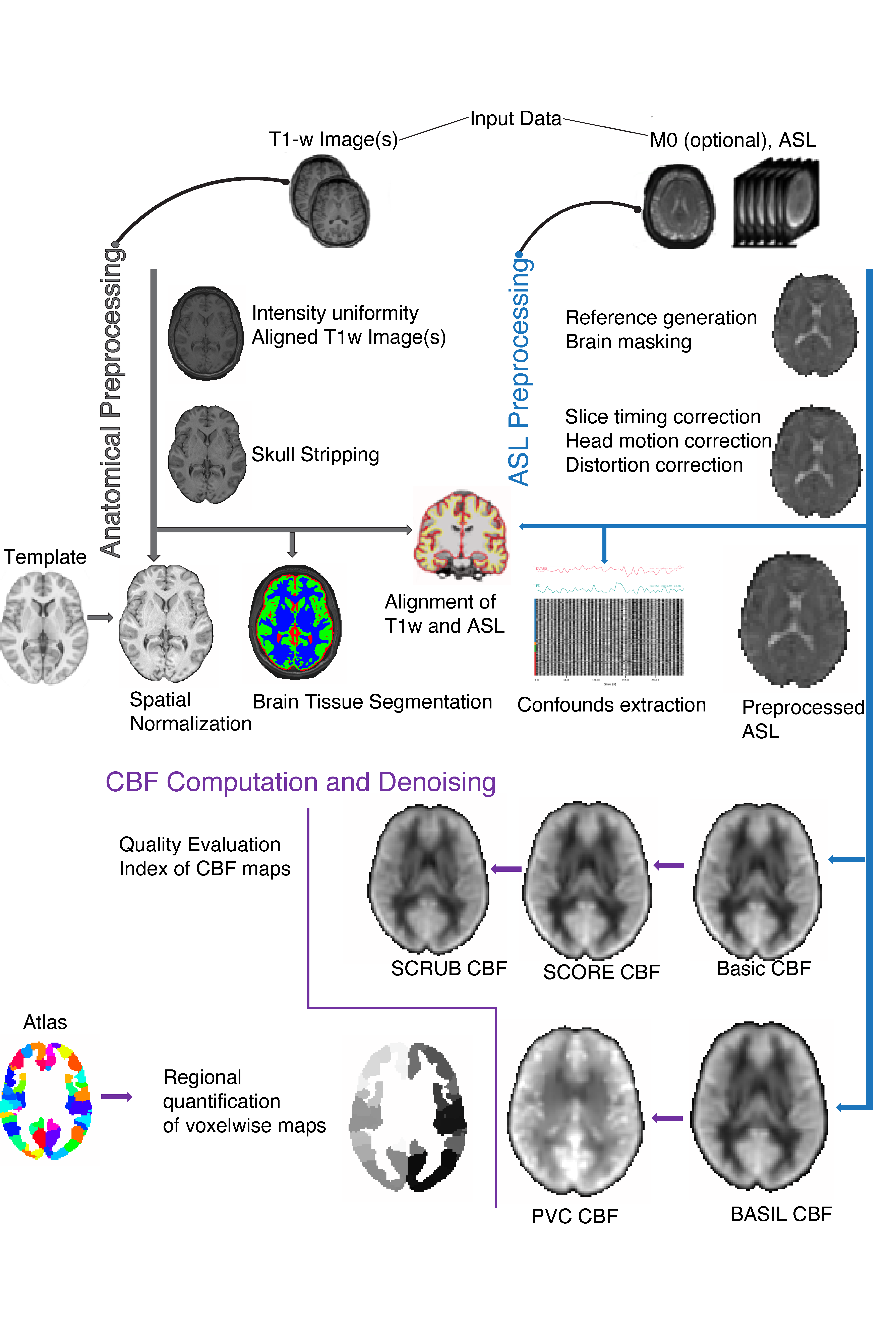



This pipeline is developed by the Satterthwaite lab at the University of Pennsylvania for use at the The Lifespan Informatics and Neuroimaging Center at the University of Pennsylvania, as well as for open-source software distribution.
ASLPrep is a Arterial Spin Labeling (ASL) data preprocessing and Cerebral Blood Flow (CBF) computation pipeline that is designed to provide an easily accessible, state-of-the-art interface that is robust to variations in scan acquisition protocols and that requires minimal user input, while providing easily interpretable and comprehensive error and output reporting. It performs basic processing steps (coregistration, normalization, unwarping, noise component extraction, segmentation, skullstripping etc.), CBF computation, denoising CBF, CBF partial volume correction, and providing outputs that can be easily submitted to a variety of group level analyses, including task-based or resting-state CBF, graph theory measures, surface or volume-based statistics, etc.
The ASLPrep pipeline uses a combination of tools from well-known software packages, including FSL_, ANTs_, FreeSurfer_ and AFNI_. This pipeline was designed to provide the best software implementation for each state of preprocessing, and will be updated as newer and better neuroimaging software become available.
This tool allows you to easily do the following:
- Take ASL data from raw to fully preprocessed form.
- Compute Cerebral Blood Flow (CBF), denoising and partial volume correction.
- Implement tools from different software packages.
- Achieve optimal data processing quality by using the best tools available.
- Receive verbose output concerning the stage of preprocessing for each subject, including meaningful errors.
- Automate and parallelize processing steps, which provides a significant speed-up from typical linear, manual processing.
More information and documentation can be found at https://aslprep.readthedocs.io/.
ASLPrep adapts the preprocessing steps depending on the input dataset and provide results as good as possible independently of scanner make and scanning parameters With the BIDS input, little or no parameter are required allowing ease of operation. ASLPrep also provides visual reports for each subject, detailing the most important processing steps.
Please acknowledge this work using the citation boilerplate that ASLPrep includes in the visual report generated for every subject processed.
ASLPrep is largely based on fMRIPrep, as ASL processing is very similar to fMRI processing. fMRIPrep is developed by a larger group and receives more regular feedback on its workflow, so we (the ASLPrep developers) try to update ASLPrep in line with fMRIPrep.
ASLPrep and fMRIPrep are both part of the NiPreps community, but ASLPrep is in a unique situation because it is owned and maintained by Ted Satterthwaite and his team. As such, while we do our best to keep ASLPrep in sync with fMRIPrep, differences may arise due to choices by leadership or, more commonly, necessarily differential processing for different modalities.
There are several crucial differences between ASL and fMRI processing, which must be accounted for in ASLPrep:
- The ASL reference image is selected from the highest-contrast volume type within the time series, rather than from the first N volumes.
- ASL processing does not include slice timing correction. Instead, post-labeling delays are shifted based on the slice timing when CBF is calculated.
- While ASL motion correction may use the same algorithm as fMRI motion correction, different volume types in the ASL time series exhibit different contrasts, which can introduce artifacts into the motion-corrected data. As such, ASLPrep motion corrects each volume type separately, and then concatenated the corrected time series back together.
- ASLPrep includes extra steps to do the following: 1. Calculate CBF. 2. Calculate CBF QC metrics, paralleling the ASL confound calculation. 3. Plot CBF results, paralleling ASL plots. 4. Parcellate CBF results with a range of atlases.
- fMRIPrep contains a lot of code to handle multi-echo fMRI. While multi-echo ASL does exist, it is very rare, so we do not include any multi-echo-specific elements in ASLPrep at the moment.
